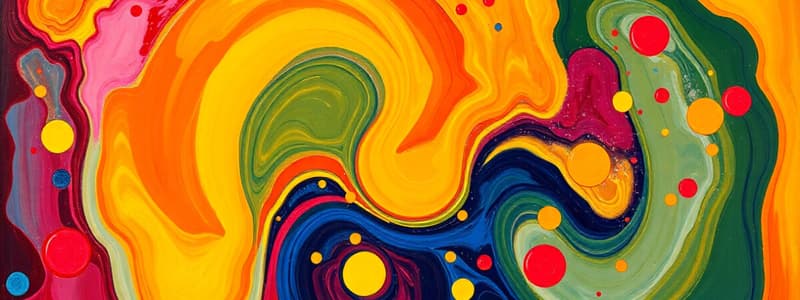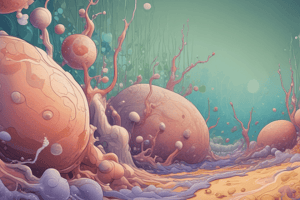Podcast
Questions and Answers
What role do enzymes play in fermentation?
What role do enzymes play in fermentation?
- They decompose organic substances quickly.
- They act as catalysts to speed up chemical reactions. (correct)
- They provide nutrients to microorganisms.
- They slow down chemical reactions.
Which of the following sugars can yeast ferment?
Which of the following sugars can yeast ferment?
- Ribose
- D-fructose (correct)
- Galactose
- Lactose
What is the purpose of Pasteur's salt solution in the experiment?
What is the purpose of Pasteur's salt solution in the experiment?
- To filter impurities from the yeast suspension.
- To provide essential nitrogen for yeast nutrition. (correct)
- To enhance the flavor of the fermentation process.
- To act as a preservative for sugars.
What equipment is NOT listed as necessary for the fermentation experiment?
What equipment is NOT listed as necessary for the fermentation experiment?
What is produced as a result of yeast fermentation when sugars are present?
What is produced as a result of yeast fermentation when sugars are present?
What is the primary enzyme responsible for converting sucrose into glucose in the experiment?
What is the primary enzyme responsible for converting sucrose into glucose in the experiment?
What is the expected color of the solution in Benedict's test before the warm water bath?
What is the expected color of the solution in Benedict's test before the warm water bath?
What indicates a positive result in the Iodoform test for ethyl alcohol?
What indicates a positive result in the Iodoform test for ethyl alcohol?
What is the final organic product produced from glucose during fermentation?
What is the final organic product produced from glucose during fermentation?
What does a cloudy white solution in the test tube with a clear lime solution indicate when reacting with carbon dioxide?
What does a cloudy white solution in the test tube with a clear lime solution indicate when reacting with carbon dioxide?
What is the outcome of the Benedict's test if fermentation is incomplete?
What is the outcome of the Benedict's test if fermentation is incomplete?
In the reaction of ethyl alcohol with iodine in potassium iodide, what is one of the products formed?
In the reaction of ethyl alcohol with iodine in potassium iodide, what is one of the products formed?
Which compound is produced as a byproduct when glucose is fermented by yeast?
Which compound is produced as a byproduct when glucose is fermented by yeast?
What happens to the color of the solution in Benedict's test after boiling if sugars have been completely converted into alcohol?
What happens to the color of the solution in Benedict's test after boiling if sugars have been completely converted into alcohol?
Which enzyme assists in the conversion of glucose into ethanol and carbon dioxide?
Which enzyme assists in the conversion of glucose into ethanol and carbon dioxide?
Flashcards are hidden until you start studying
Study Notes
Fermentation
- Fermentation is the breakdown of organic substances by microorganisms, primarily through enzymes.
- Yeast, single-celled organisms, play a crucial role in fermentation.
- Yeast contain enzymes like zymase and invertase, which catalyze chemical reactions.
- Pasteur's salt solution provides essential nitrogen for yeast growth.
- Yeast ferments various sugars, including glucose, mannose, fructose, sucrose, and maltose, but not lactose. Fermentation with galactose is challenging.
Experiment 9 - Fermentation
- Purpose: To demonstrate fermentation of sucrose using yeast and test for ethyl alcohol and sugar.
- Materials: Brown sugar (sucrose), yeast suspension, clear lime water solution (calcium hydroxide), sodium hydroxide solution, iodine solution, Benedict's solution, filter paper, and other lab equipment.
- Procedure:
- Dissolve sugar in hot water, cool, and add yeast suspension.
- Connect an Erlenmeyer flask containing the mixture with a delivery tube to a test tube with lime water.
- Observe changes over time, including foam formation and the formation of a cloudy precipitate in the lime water solution.
- Decant and filter the mixture, then test the filtrate for alcohol and sugar.
- Results and Observations:
- Fermentation Flask: Formation of molds and a foamy white layer.
- Lime Water Test Tube: Formation of a cloudy white precipitate (calcium carbonate) due to the reaction of carbon dioxide with calcium hydroxide.
- Filtrate:
- Yellowish color.
- Alcohol odor.
- Chemical Equations:
- Sucrose Hydrolysis: C12H22O11 (sucrose) + H2O → 2C6H12O6 (glucose) - Enzyme: Invertase
- Glucose Fermentation: 2C6H12O6 (glucose) → 4CH3CH2OH (ethanol) + 4CO2 - Enzyme: Zymase
- Lime Water Reaction: Ca(OH)2 (calcium hydroxide) + CO2 (carbon dioxide) → CaCO3 (calcium carbonate) + H2O (water)
- Iodoform Test (for Ethyl Alcohol):
- Add NaOH solution and iodine solution to the filtrate.
- If ethyl alcohol is present, a yellow precipitate of iodoform (CHI3) forms after heating.
- Chemical Equation: C2H5OH (ethyl alcohol) + 4I2 (iodine) + 6NaOH (sodium hydroxide) → CHI3 (iodoform) + HCOONa (sodium formate) + 5NaI (sodium iodide) + 5H2O (water)
- Benedict's Test (for Sugar):
- Add Benedict's solution to the filtrate.
- If sugar is present, a brick-red precipitate of copper (I) oxide (Cu2O) forms after heating.
- Chemical Equation: C6H12O6 (aldehyde, like glucose) + Benedict's Solution → Cu2O (copper (I) oxide)
- A negative result indicates complete fermentation where all sugars are converted to alcohol.
Experiment 10 - Reactions of Alcohols and Phenols
- Purpose: To explore the reactions of alcohols and phenols.
- Materials: Various alcohols (ethyl, methyl, isopropyl, tert-butyl), calcium carbide, copper sulfate, acetic acid, sulfuric acid, salicylic acid, sodium hydroxide, iodine solution, potassium dichromate, hydrochloric acid, zinc chloride, ferric chloride, phenol, resorcinol, and other lab equipment.
- Procedure: The text appears to be incomplete, but it likely involves conducting various chemical reactions with alcohols and phenols and observing the resulting changes.
Studying That Suits You
Use AI to generate personalized quizzes and flashcards to suit your learning preferences.




